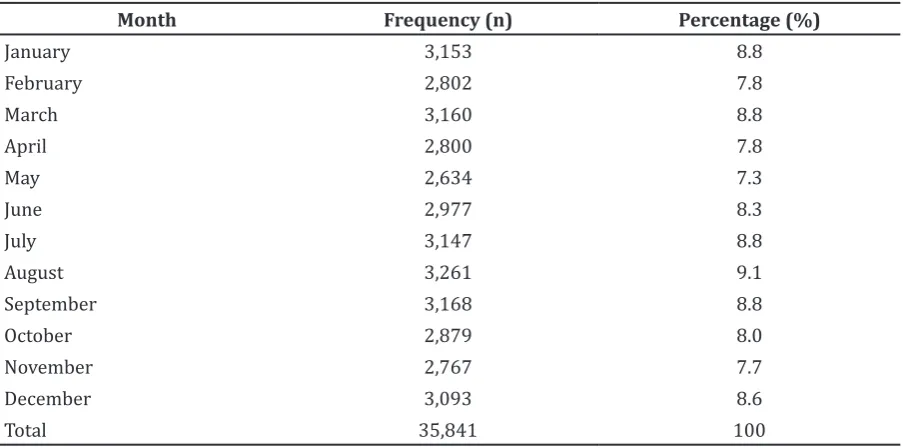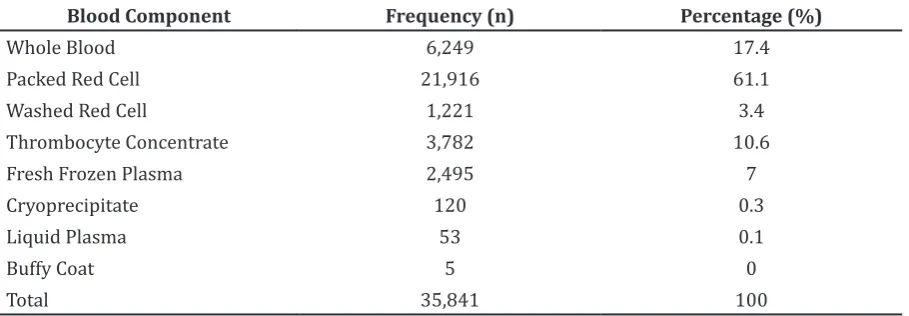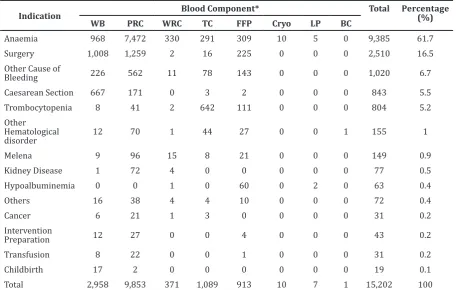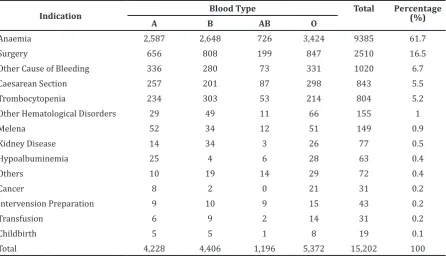Profile of Blood Transfusion Requests from Hospitals to Bandung
Blood Transfusion Unit, Indonesian Red Cross in 2011
Syahla Nisaa Amalia,1 Nadjwa Zamalek D,2 Januarsih A. Rachman3
1Faculty of Medicine Universitas Padjadjaran, 2Department of Clinical Pathology Faculty of
Medicine, Universitas Padjadjaran/Dr. Hasan Sadikin General Hospital Bandung, 3Department of
Anatomy and Cell Biology Faculty of Medicine Universitas Padjadjaran Bandung
Abstract
Background: Blood transfusion as a part health services should be provided under appropriate indications and in a safe manner. In Indonesia, blood collection is run by the Blood Transfusion Unit of Indonesian Red
Cross, where the blood is screened, processed into blood components, and finally distributed to hospitals. The purpose of this study was to describe the profile of blood transfusion requests from hospitals that do
not have blood bank facility to the Bandung Blood Transfusion Unit, Indonesian Red Cross.
Methods: A descriptive study was carried out using secondary data from Bandung Blood Transfusion
Unit Indonesian Red Cross (UTD PMI Bandung). All blood request forms from hospitals during 2011 were
collected and analyzed. Variables in this study were the amount of blood units, blood components, blood type, and indications of blood transfusion.
Results: The number of blood units requested by hospitals were 35,841 units. The most blood units requested was in August 2011. The blood component requested was the packed red cell (61.1%), whole blood (17.4%), thrombocyte concentrate (10.6%), and fresh frozen plasma (7%). The total percentage of O, A, B and AB blood types were 36.1%, 28.6%, 27.5%, and 7.9% respectively. The most frequent indication for transfusion was anemia (61.7%), followed by surgery and other causes of bleeding.
Conclusions: The total blood units requested by hospitals vary each month. The most blood component requested is Packed Red Cell and the type of blood is O blood type. The most frequent indication is anemia.
[AMJ.2015;2(3):433–39]
Keywords: Anemia, blood transfusion, blood type, packed red cell
Correspondence: Syahla Nisaa Amalia, Faculty of Medicine, Universitas Padjadjaran, Jalan Raya Bandung-Sumedang Km.21, Jatinangor, Sumedang, Indonesia, Phone: +6287823392175 Email: [email protected]
Introduction
According to the World Health Organization (WHO), transfusion medicine is a part of a
healthcare system that manages the supply and use of human blood. Transfusion is performed to replace lost blood from the body, which can be caused by trauma or the body has lost its ability to produce blood properly.1,2 Blood transfusion can give benefits
to the recipients, but it can also carry risks or cause complications. Dangerous infections might be transmitted to the recipients if the transfusion was given without following the correct procedures.3 Blood transfusion has to
be conductedaccording to the indication for each blood component.4,5 Blood components given to recipients are Whole Blood, Packed Red Cell, Washed Red Cell, Thrombocyte
Concentrate, Fresh Frozen Plasma, Liquid
Plasma, Crypoprecipitate, and Buffy Coat.3,5
Before requesting blood to a Blood
Transfusion Unit for transfusion purpose,
a clinician should fill a blood request
form. The form consists of information on patient's identity, indication for transfusion, type of blood component and its amount, blood transfusion time, and other related information which have to be submitted correctly and completely by the clinician.6 The next step is to take a blood sample from the patient. This blood sample will be used for compatibility testing to obtain the appropriate
blood for optimum safety, efficiency of the
transfusion, and to avoid destruction of the transfused blood.5,6 One of the most important steps in compatibility testing is to determine the blood type of the patient. The blood type
434 AMJ September, 2015
(Rh) blood types.4-6 In the ABO blood type system, there are four types of blood groups,
which are: A, B, AB, and O. Different from the ABO blood type system, the Rhesus system
consists only two types, Rhesus positive and negative.4,5
Data from the American Red Cross show that, in average , in every two seconds a person
requires blood in the United States. This means that 4.5 million Americans need blood
each year.7,8 In America, about 60% people
are eligible to be blood donor, but only 5% of
them become donors.9 In Indonesia, about 4.5
million blood units are needed, but only 3.5 million can be fullfilled.10
The Blood Transfusion Unit of the Indonesian Red Cross (Unit Transfusi Darah Palang Merah Indonesia, UTD PMI) is an organization that provides blood transfusion service in Indonesia. Blood transfusion service is provided by PMI, begins with mobilizing people to donate their blood, blood extraction, securing and storing the blood, processing blood into several components, as well as distributing them to the Hospital Blood Bank (Bank Darah Rumah Sakit, BDRS). The hospital will distribute these bloods to the recipients who need the blood or its component. Hospital Blood Bank is a working unit in a hospital, which assist in distributing blood transfusion to the recipients. The BDRS receives blood from the local Blood Transfusion Unit. The
establishment of BDRS has to follow specific criteria; however, not all hospitals can meet
the criteria to establish a BDRS.11
The purpose of this study was to describe
the profile of blood requests to UTD PMI
Bandung from hospitals without BDRS facility
in the year 2011. This included the amount of total blood requested based on blood type,
components, and its indication.
Methods
A descriptive study was carried out in UTD PMI Bandung. The study was performed using
secondary data in blood request forms sent to
the UTD PMI Bandung from hospitals without blood bank facility. The permission to conduct this study was given by UTD PMI Bandung
before data collection began. All blood request
forms from hospitals without blood bank
facility to UTD PMI Bandung during 2011 were
collected and analyzed.
Data from blood request forms were
entered into computer and analyzed by using
frequency distribution presented in either tables or figures. Observed variables in this
study were number of blood units, blood type, type of blood components, and indication of blood transfusion. The indications for blood transfusion were grouped into several categories.
Results
The total number of blood request to the
UTD PMI Bandung from hospitals without
blood bank facility was 17,504, requesting Table 1 Number of Blood Requests per Month
Month Frequency (n) Percentage (%)
35,841 blood units (2 units per patient). Only 7,872 (45%) were completely filled and only 15,202 (42.4%) blood unit requests included
information on the indication.
Table 1 shows that the number of blood unit
requested each month varies. Most requests
were made in August. The average number of
blood units requested per month was 2,987
blood units.
In table 2, the number of blood requested based on blood component in year 2011 is
listed. Twenty one thousand nine hundred and
sixteen (61.1%) Packed Red Cell units were requested, followed by Whole Blood of 6,249 (17.4%), Thrombocyte concentrate of 3,782 (10.6%), Fresh Frozen Plasma of 2,495 (7%), Washed Red Cells of 1,211 (3.4%) blood units, Cryoprecipitate of 120 (0.3%), Liquid Plasma
of 53 (0.1%), and Buffy Coat of 5 (0%).
Figure 1 shows the percentage of each
ABO blood type requested in the year of 2011.
Figure 1 shows that the blood type most
requested by hospitals without blood bank facility in 2011 was type O with a percentage of 36.1%, followed by type A, B, and AB (28.6%, 27.5%, and 7.9% respectively).
The percentages of each indication can be seen in Table 3. Anemia was the highest indication followed by surgery. Table 3 shows
the amount of blood requested based on
indications and blood components by hospitals without blood bank facility. Some indications were grouped into several categories, such as other hematological disorder, other cause of bleeding, and others. For example, other hematological disorders are anaemia
Table 2 Number of Blood Requests Based on Blood Component
Blood Component Frequency (n) Percentage (%)
Whole Blood 6,249 17.4
Packed Red Cell 21,916 61.1
Washed Red Cell 1,221 3.4
Thrombocyte Concentrate 3,782 10.6
Fresh Frozen Plasma 2,495 7
Cryoprecipitate 120 0.3
Liquid Plasma 53 0.1
Buffy Coat 5 0
Total 35,841 100
436 AMJ September, 2015
and thrombocytopenia, Disseminated Intravascular Coagulation, Hemophilia, Hereditary Pyropoikilocytosis, Idiopathic Thrombocytopenic Purpura, Leukemia and Thrombocytopenia, Myeloid Leukemia, Pancytopenia, low PCV, PPT, Thallassemia,
and also prolonged bleeding. Other causes
of bleeding indications are epistaxis, bloody cough, hematemesis, gum bleeding, intra-partum bleeding, vaginal bleeding, post-partum bleeding, placenta previa, and rupture. In addition, other indications are acidosis and hipoalbumin, common cold, malaria, general recovery, sepsis, septic arthritis, cirrhosis, and many unknown abbrevitation.
The result of this study presented in Table 3 shows the highest amount of blood component
requested by hospitals was Packed Red cell,
followed by Whole blood, Thrombocyte Concentrate and Fresh Frozen Plasma.. Indication for Whole Blood component was
surgery (34.1%), followed by anaemia (32.7%). Packed Red Cell was the most requested blood
component in almost all indications. The three highest indications for Packed Red Cell
were anaemia (75.8%), surgery (12.7%), and other causes of bleeding (5.7%). The three
highest indications for Washed Red Cell were
anaemia (88.9%), melena (4%), and other causes of bleeding (2.9%). The three highest
indications Thrombocyte Concentrate were
thrombocytopenia (58.9%), anaemia (26.7%), and other causes of bleeding (7.1%). The three
highest indications for Fresh Frozen Plasma
were anaemia (33.8%), surgery (24.6%), and other causes of bleeding (15.6%).
Table 4 shows the number of each ABO blood type requested by hospitals without
blood bank facility based on indications. Blood
type O was the most requested by hospitals,
followed by type B, A and AB.
Discussion
Packed Red Blood Cell is the most requested component in theyear 2011. This finding was
in accordance with thetheory proposed by Kaplan and Skerrett that the most transfused blood component is the Packed Red Cell.12
The request for Whole Blood decreases, since requesting of specific blood component
increases.13 Packed Red Cell is a blood
component given to increase the oxygen-carrying capacity or to speed up the delivery of
Table 3 Number of Blood Request Based on Indication and Blood Component
Indication Blood Component* Total Percentage (%)
WB PRC WRC TC FFP Cryo LP BC
Anaemia 968 7,472 330 291 309 10 5 0 9,385 61.7
Surgery 1,008 1,259 2 16 225 0 0 0 2,510 16.5
Other Cause of
Bleeding 226 562 11 78 143 0 0 0 1,020 6.7
Caesarean Section 667 171 0 3 2 0 0 0 843 5.5
Trombocytopenia 8 41 2 642 111 0 0 0 804 5.2
Other
Total 2,958 9,853 371 1,089 913 10 7 1 15,202 100
oxygen to the cells of the body. The condition with low oxygen-carrying capacity could be found such as in decreased bone marrow production, decreased life span of red blood cells, and chronic or acute hemorrhage (surgical or traumatic). Administration of Packed Red Cell does not only depend on the hemoglobin level, but also depends on the clinical symptoms and the status of hemodynamic. The hemoglobin level is not an absolute indicator for transfusion because the body has compensatory mechanism to adapt with low level of hemoglobin in the body. In that case, the transfusions are not necessary unless a sign of anemia is seen.3,15-17 Packed Red
Cell is often requested only based on anemic,
without any information of the hemoglobin level or severity of anemia.15,16
Whole Blood can be given for active bleeding. In this case, the loss of red blood cells and decrease of blood volume can occur simultaneously, such as in surgery, childbirth, and caesarean section.4 In all these conditions, there was no information regarding active bleeding. In addition, Table 3 shows that there was a demand for Whole Blood for thrombocytopenia. This situation is not in accordance with the theory. Thrombocyte blood components should be given for thrombocytopenia.4
Washed Red Cell is erythrocyte, which washed by using the sterile normal saline.
Theoretically, Washed Red Cell is to prevent an allergic reaction, such as in people with
IgA deficiency were given transfusion of
Packed Red Cell, due to the presence of plasma containing IgA.15,16 A total of 371 Washed Red
Cell was requested, most of them based on
indication of anemia.
Thrombocyte concentrates are given to prevent or treat active bleeding associated with thrombocytopenia, however not all thrombocytopenia should be treated with thrombocyte concentrates. The administration of thrombocyte concentrate component depends on the clinical condition, the cause of thrombocytopenia, platelet count, and platelet function of patients.16 The indication of thrombocyte concentrate transfusion is in accordance with the indications of trombcytopenia, but the indication of thrombocytopenia was not clearly mentioned.
Additionally, there were 251 units of thrombocyte concentrate requested for
anemia.
Fresh frozen plasma consists of many proteins, including coagulation factors, albumin, and immunoglobulins. Furthermore, fresh frozen plasma administration is used to prevent or treat patients with active bleeding due to coagulation abnormalities caused by massive transfusion or liver disease, or prolonged prothrombin time and partial thromboplastine time.4,5,12,18 Table 3
Table 4 Number of Blood Request Based on Indication and Blood Type
Indication Blood Type Total Percentage (%)
A B AB O
Anaemia 2,587 2,648 726 3,424 9385 61.7
Surgery 656 808 199 847 2510 16.5
Other Cause of Bleeding 336 280 73 331 1020 6.7
Caesarean Section 257 201 87 298 843 5.5
Trombocytopenia 234 303 53 214 804 5.2
Other Hematological Disorders 29 49 11 66 155 1
Melena 52 34 12 51 149 0.9
Kidney Disease 14 34 3 26 77 0.5
Hypoalbuminemia 25 4 6 28 63 0.4
Others 10 19 14 29 72 0.4
Cancer 8 2 0 21 31 0.2
Intervension Preparation 9 10 9 15 43 0.2
Transfusion 6 9 2 14 31 0.2
Childbirth 5 5 1 8 19 0.1
438 AMJ September, 2015
shows that many fresh frozen plasma were used for anemia, but there was no further information regarding thecoagulation status. Cryoprecipitate is a blood component derived from Fresh Frozen Plasma, which contains factor VIII, von Willebrand factor, factor XIII,
fibrinogen and fibronectin. Cryoprecipitate
is usually used for patients with hemophilia A, von Willebrand (VWD) disease, and
hypofibrinogenaemia related bleeding.3,5,19
Liquid plasma is the liquid component from
Fresh Frozen Plasma stored in 24 hours
to 5 days after thawed.15 Table 3 shows
cryoprecipitate and liquid plasma were given
to patients with anemia, but theoritically there is no indication for anemia.
Buffy coat is a concentrate of white blood cells and platelets obtained at the time centrifugation. Indications for Buffy Coat are infants with septic neutropenic and less neutrophil counts, and in infants with sepsis
and bad neutrophil function.20 Due to limited data obtained, it was difficult to compare with
the established theories.
Blood type O is the most requested with percentage as much as 36.1%. Data from the
American Red Cross shows that blood type
O is the most requested by the clinicians.7
Most people in the world have blood type O,
followed by type A, B, and AB.14
This study had limitations. From a total
of 35,841 blood units requested, only 15,202 (42.4%) blood units were known the
indications. Therefore, the results of this study
could not definitively prove why the blood was needed. There were many forms filled with
several terminology with the same meaning. Based on the results, it can be concluded that
the total blood units requested by hospitals varied each month, but the most requested was
in August. The type of blood component most
frequently requested is Packed Red Cell and O bloodtype. The three frequent indications are
anemia, surgery and other causes of bleeding.
References
1. National Heart, Lung, and Blood Institute.
What is a blood transfusion ?; 2012 [cited 19 April 2012]; Available from: http://
www.nhlbi.nih.gov/health/health-topics/ topics/bt/.
2. Natukunda B, Schonewille H, Sibinga CTS. Assessment of the clinical transfusion practice at a regional referral hospital in
Uganda. Transfus Med. 2010;20(3):134–9.
3. Koh MBC, Lee YS, Chay J. Appropriate blood component usage. ISBT Science
Series. 2011;6(2):249–56.
4. WHO. The clinical use of blood: handbook.
Geneva: WHO Library Cataloguing in Publication Data; 2002.
5. Hillyer CD, Shaz BH, Zimring JC, Abshire
TC. Transfusion medicine and hemostasis: clinical and laboratory aspects. Oxford: Elsevier; 2009.
6. Roxby D. Current concepts in pre-transfusion serological compatibility
testing. ISBT Science Series. 2011;6(2):265-9.
7. American Red Cross. Blood facts and
statistics [cited 2012 November 25]; Available from: http://www.
redcrossblood.org/learn-about-blood/ blood-facts-and-statistics.
8. Health Watch Center. Blood facts and
statistics (infographics); 2011 [cited 2013 February 9]; Available from: http://www.
healthwatchcenter.com/2011/12/blood-facts-and-statistics/
9. New York Blood Center. Blood statistics.; [cited 2012 December 2]; Available from: http://www.nybloodcenter.org/blood-statistics.do?sid0=85&page_id=202. 10. Arriani A. Ayo, bersama berbagi kebaikan.
Palang Merah Indonesia; 2012 [cited 2012 December 2]; Available from: http://www.pmi.or.id/ina/news/default. asp?act=detail&p_id=847.
11. UTD PMI Pusat. Pedoman pelayanan
transfusi darah. 3rd ed. Jakarta; 2007.
12. Kaplan HS, Skerrett DL. Types of transfusion.
Merck Manual Home Health Handbook; 2007 [cited 2012 May 1]. Available from: http://www.merckmanuals.com/home/ blood_disorders/blood_transfusion/ types_of_transfusions.html.
13. Cronan KM. Surgeries and procedures:
blood transfusion. The Nemours
Foundation; 2012 [cited 2012 November 25]; Available from: http://kidshealth. org/parent/system/surgery/blood_
transfusion.html#.
14. O’Neil D. Distribution of blood types.
Modern Human Variation:An Introduction
to Contemporary Human Biological
Diversity;1998-2012 [cited 25 November 2012] Available from: http://www.anthro. palomar.edu/vary/vary_3.htm.
15. Harmening DM. Modern blood banking
& transfusion practices. 5th ed. Melanie
S. Kennedy M, Haifeng M. Wu M, editors.
Philadelphia: F. A. Davis Company; 2005. 16. McCullough J. Transfusion medicine. 2nd
ed. Philadelphia: Elsevier; 2005.
Piccoli P, Rossetti G. Recommendations for the transfusion of red blood cells. Blood
Transfusion. 2009;7(1):49–64.
18. Moiz B, Arif FM, Hashmi KZ. Appropriate and inappropriate use of fresh frozen
plasma. J Pak Med Assoc. 2006;56(8):356– 9.
19. Droubatchevskaia N, Wong MP,
Chipperfield KM, Wadsworth LD, Ferguson
DJ. Guidelines for cryoprecipitate
transfusion. BCMJ. 2007;49(8):441–5. 20. Charge Nurse - Newborn. Buffy Coat
Concentrate. Newborn services clinical
guideline;2003 [cited 2012 December 2] Available from: http://adhb.govt.



